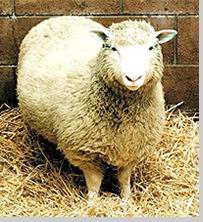|
History
of Cloning
Cloning is not new.
Experiments with frogs and toads(蟾蜍)date back to the
1970s. And experiments involving plants and animal embryos
have been performed for years. But experiments involving
human beings have never been tried or thought possible,
until "Dolly". Her birth shocked the scientific
community and has spurred discussion about the possibility
of human clones. Dr. Lee Silver, a molecular biologist
at Princeton University, is optimistic that "human
cloning will occur," and that "it might take
five years, ten years at the outermost." Lee notes
that at this time, "no ethical doctor would do
human cloning". Although this view is predominant(占主导地位的)among
many scientists, some argue that a safe technology could
be developed in the future. This has led to discussion
about whether human cloning should even be legally possible.
|

|
|
Dolly
Mary had a little lamb, its fleece was slightly grey,
It didn't have a father, just some borrowed DNA.
It sort of had a mother, though the ovum(卵细胞)was on
loan,
It was not so much a lambkin, as a little lamby clone.
And soon it had a fellow clone, and soon it had some
more,
They followed her to school one day, all cramming through
the door.
It made the children laugh and sing, the teachers found
it droll(古怪),
There were far too many lamby clones for Mary to control,
No other could control the sheep, since their programs
didn't vary,
So the scientists resolved it all, by simply cloning
Mary.
But now they feel quite sheepish, those scientists unwary(不谨慎),
One problem solved, but what to do, with Mary, Mary,
Mary.
|